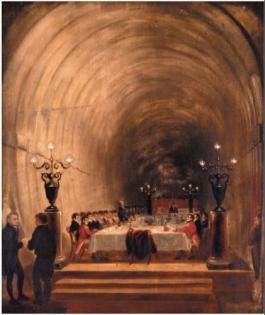The long delayed tunnel beneath the Thames, between Wapping and Rotherhithe, finally opens. Proposed in 1805, work didn't begin on the project until 1825. In all, the project had had so many fits and starts that Londoners called it "The Great Bore." The storied engineer, Isambard Kingdom Brunel, who'd succeeded his father Marc, finished the job but at a cost four times the original estimate. The final price tag is a staggering £614,000.
Construction of the world's first major-underwater tunnel was dangerous work. In 1828, the tunnel walls collapsed, drowning six men. The younger Brunel narrowly escaped: "While standing there the effect was grand - the roar of the rushing water in a confined passage, and by its velocity rushing past the opening was grand, very grand ... the sight and the whole affair was well worth the risk." Work was halted for seven years. Drowning was only one danger; many men were left "insensible" by the dangerous pressures generated in the tube. Not to mention the constant stench and threat of disease from a simple fall into the polluted river.
The opening day ceremonies are plagued with delays and The Times correspondent says the overcrowded room where dignitaries gathered at the Wapping entrance developed "an atmosphere at once disgustingly heated and fetid." A band from the Fusiliers Guards leads the way down the 1200 foot long tunnel and the reverberating music coupled with the sound of dripping water produced, notes the Timesman, "a lurking chilling fear in the breasts of many." Rising back to daylight in Rotherhithe, several invited guests opt to go back across via London bridge.
The tunnel is an immediate financial success; by year's end, more than a million people had paid a penny to stroll beneath Father Thames. The novelty faded however, and the tunnel soon became the haunt of ruffians and prostitutes. It was converted for railway use in the 1860's and is still in use today, carrying the Underground's East London Line.

Hi Tom. Can you tell me if the picture of the 1843 Thames Tunnel event is copyrighted as I would like to use it in my book?
ReplyDelete